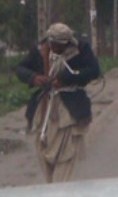
This is effectively “So What Does My Book Say About Afghanistan? – part 6. It is continuing the discussion on Afghanistan drawn from fragments of text from pages 262-264 of America’s Modern Wars:
DUELING SURGES
Afghanistan shows that a surge and good tactics alone do not win insurgencies. It is claimed by some that this is what turned around Iraq, but in fact, what was most important to correcting Iraq was buying off of the insurgents and forming the Iraq Sunni Awakening Councils. Without a successful buy off in Afghanistan, the surge and good U.S. tactics have not turned the situation around and by itself, will not. In the end, you still need to have sufficient troops on the ground to control the terrain, protect the population, and contain the insurgents. There are few shortcuts that allow you to avoid the basics.
….[skipped several paragraphs describing how the surges worked in Iraq and Afghanistan]…
…So, 36 months into the start of the strength increase done by President Obama [in Afghanistan], there is no drop in the level of violence. Only in 2012, after it was clear that the U.S. and coalition forces were withdrawing, does the level of violence drop. In contrast the surge in Iraq achieved a measurable result in nine months.
The difference between the two is striking and clearly makes the point that the whole strategic situation needs to be fully addressed and these problems cannot be solved by simply applying a technique from one war to the next. The surge in Afghanistan is simply larger, more sustained and has achieved less dramatic results when compared to the rather limited and brief surge in Iraq.
(to be continued)

“buying off the insurgents” that is pretty much inline with Jacqueline Hazelton’s thesis.
I had no idea that the Iraq intervention had resort to – “what was most important to correcting Iraq was buying off of the insurgents and forming the Iraq Sunni Awakening Councils.”
I had thought it was mostly or entirely military.
That is more enlightened than I had realised.
I wonder if anything like that was tried in Vietnam.
No, “the surge” in Iraq did not turn it around. It was forming and funding the Iraq Sunni Awakening Councils that resulted in the sudden improvement of the situation. This effort was initially at the initiative of some Iraqi sheiks. The Awakening Councils and “the surge” were both going on at the same time. The fact that some people credited “the surge” with such success resulted in them trying the same thing in Afghanistan. It did not work. A temporary year or two troop surge, by its very nature, is not going to have a long-term impact on a multi-decade insurgency.
The Sunni Awakening Councils have been written about by a number of people. Jim Michaels, A Chance in Hell, is a decent account.